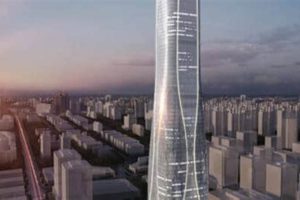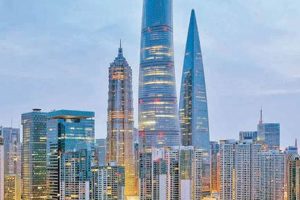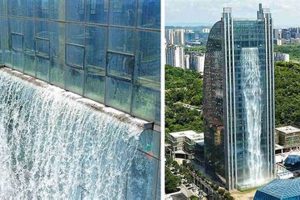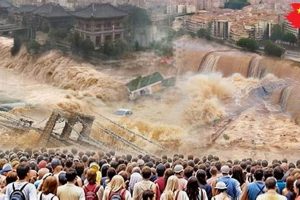Painting skyscrapers is a specialized and complex task that requires careful planning, preparation, and execution. It involves applying protective coatings to the exterior of high-rise buildings to protect them from the elements and maintain their structural integrity.
Painting skyscrapers offers several important benefits. First, it protects the building’s exterior from the damaging effects of UV radiation, moisture, and temperature fluctuations. Second, it can improve the building’s energy efficiency by reflecting sunlight and reducing heat absorption. Third, a fresh coat of paint can enhance the building’s overall appearance and aesthetic appeal.
The process of painting a skyscraper typically involves several steps. First, the building’s exterior is thoroughly cleaned to remove dirt, debris, and any existing paint. Next, any necessary repairs are made to the building’s surface. Once the surface is prepared, a primer is applied to help the paint adhere to the building. Finally, multiple coats of paint are applied to the building’s exterior, with each coat being allowed to dry completely before the next coat is applied.
1. Safety
When painting skyscrapers, safety is of the utmost importance. Working at high altitudes poses unique challenges and requires extensive safety measures to protect workers from falls, falling objects, and other hazards. Specialized equipment, such as safety harnesses, lifelines, and scaffolding, is essential for ensuring the safety of workers during painting operations.
- Fall Protection
Preventing falls is a top priority when working at high altitudes. Workers wear safety harnesses that are attached to lifelines, which are secured to the building’s structure. This prevents workers from falling if they lose their balance or slip.
Falling objects pose a significant hazard to workers painting skyscrapers. Debris, tools, and other objects can fall from great heights, causing serious injury or death. To mitigate this risk, workers use debris nets and tarps to catch falling objects and protect workers below.
- Scaffolding and Aerial Lifts
Scaffolding and aerial lifts provide safe and stable work platforms for painters working at high altitudes. Scaffolding is a temporary structure that is erected around the building, while aerial lifts are mobile platforms that can be raised and lowered to reach different areas of the building’s exterior.
- Training and Supervision
Proper training and supervision are essential for ensuring the safety of workers painting skyscrapers. Workers must be trained on the use of safety equipment, fall prevention techniques, and emergency procedures. Supervisors must monitor workers and ensure that they are following safety protocols.
These safety measures are essential for protecting workers and ensuring the successful completion of painting projects on skyscrapers. By implementing these measures, building owners and contractors can minimize risks and create a safe working environment for their employees.
2. Preparation
When painting skyscrapers, meticulous preparation is paramount to ensure the paint adheres properly and provides long-lasting protection. This involves thoroughly cleaning the building’s exterior to remove dirt, dust, and other contaminants that could interfere with the paint’s bond. Any necessary repairs, such as patching cracks or caulking gaps, must also be completed before painting to prevent moisture from penetrating the building’s structure.
- Surface Cleaning
The building’s exterior is typically cleaned using a combination of high-pressure water jets and detergents to remove dirt, dust, and other contaminants. This ensures a clean and sound surface for the paint to adhere to, maximizing its durability and protective qualities.
- Repairing Cracks and Gaps
Any cracks or gaps in the building’s exterior must be repaired before painting to prevent moisture from penetrating the structure. This involves filling cracks with a suitable sealant or caulk and replacing any damaged or missing components, such as loose tiles or bricks.
- Rust Removal
In cases where the building’s exterior has been affected by rust, it is essential to remove the rust before painting. This can be done using abrasive methods, such as wire brushing or sandblasting, or by applying a rust-converting solution.
- Priming
Once the building’s exterior has been cleaned and repaired, a primer is applied to help the paint adhere better and provide additional protection against the elements. The primer is typically a thin, fast-drying coating that penetrates the surface of the building and creates a uniform base for the paint.
By thoroughly preparing the building’s exterior before painting, painters can ensure that the paint will adhere properly, provide long-lasting protection, and enhance the overall appearance of the skyscraper.
3. Materials
When painting skyscrapers, the choice of materials is crucial for ensuring the durability and protection of the building’s exterior. High-quality paints and coatings are specially formulated to withstand the harsh conditions that skyscrapers face, including exposure to UV radiation, extreme temperatures, and moisture.
The use of high-quality paints and coatings provides several important benefits for skyscrapers. First, these coatings provide excellent protection against UV radiation, which can damage the building’s exterior over time, causing fading, chalking, and cracking. Second, these coatings are designed to withstand extreme temperatures, preventing the paint from peeling, blistering, or cracking due to heat or cold. Third, high-quality coatings provide a waterproof barrier that protects the building’s exterior from moisture penetration, which can lead to structural damage and mold growth.
Real-life examples demonstrate the importance of using high-quality paints and coatings for skyscrapers. The Burj Khalifa, the world’s tallest building, is protected by a specializedsystem that provides excellent UV resistance and durability. The Empire State Building, another iconic skyscraper, recently underwent a major renovation that included the application of a new high-performance coating system designed to protect the building’s exterior from the harsh New York City climate.
Understanding the connection between high-quality materials and the durability and protection of skyscrapers is essential for building owners and managers. By investing in high-quality paints and coatings, they can ensure that their buildings remain protected
from the elements, maintain their aesthetic appeal, and provide a safe and comfortable environment for occupants.
4. Equipment
When painting skyscrapers, specialized equipment is essential for safely and efficiently accessing the building’s exterior. Aerial lifts and scaffolding provide stable and elevated work platforms, allowing painters to reach all areas of the building’s facade. The use of this equipment ensures a high level of safety and productivity, enabling painters to complete their work to a high standard.
Aerial lifts are mobile platforms that can be raised and lowered, providing access to different levels of the building’s exterior. They are particularly useful for reaching areas that are difficult to access using traditional ladders or scaffolding. Scaffolding, on the other hand, is a temporary structure that is erected around the building, providing a stable and secure work platform for painters to work on. It is commonly used for large-scale painting projects or when access to the building’s exterior is limited.
The Burj Khalifa, the world’s tallest building, provides a real-life example of the importance of specialized equipment in painting skyscrapers. The exterior of the Burj Khalifa was painted using a combination of aerial lifts and scaffolding, allowing painters to safely and efficiently access all areas of the building’s facade. The use of specialized equipment ensured that the painting project was completed to the highest standards, giving the Burj Khalifa its iconic appearance.
Understanding the connection between specialized equipment and painting skyscrapers is crucial for ensuring the safety and efficiency of painting projects. By using the right equipment, painters can access all areas of the building’s exterior, complete their work to a high standard, and maintain the aesthetic appeal of these iconic structures.
5. Planning
When painting skyscrapers, careful planning is essential to ensure the safety and efficiency of the project. This involves meticulously planning every aspect of the painting process, from the preparation and cleaning of the building’s exterior to the selection of materials and equipment. Proper planning helps to minimize risks, avoid delays, and ensure that the painting project is completed to the highest standards.
One of the key elements of planning for skyscraper painting is the development of a detailed work schedule. This schedule outlines the tasks that need to be completed, the order in which they will be performed, and the estimated time frame for each task. A well-planned schedule helps to ensure that the project stays on track and that all tasks are completed in a timely and efficient manner.
Another important aspect of planning is the selection of the right materials and equipment. The type of paint, primer, and other materials used will depend on the specific requirements of the skyscraper and the environmental conditions. The choice of equipment, such as aerial lifts and scaffolding, will also depend on the height and complexity of the building. Careful planning ensures that the right materials and equipment are available when needed, minimizing delays and ensuring a smooth workflow.
Real-life examples demonstrate the importance of careful planning in painting skyscrapers. The Empire State Building, one of the world’s most iconic skyscrapers, underwent a major repainting project in 2019. The project involved meticulous planning and preparation, including the development of a detailed work schedule, the selection of high-quality materials, and the use of specialized equipment. As a result, the repainting project was completed on time and within budget, giving the Empire State Building a fresh and renewed look.
Understanding the connection between planning and painting skyscrapers is crucial for building owners, managers, and contractors. By investing in careful planning, they can ensure that painting projects are completed safely, efficiently, and to the highest standards. This not only enhances the aesthetic appeal of skyscrapers but also protects these iconic structures from the elements and ensures their long-term integrity.
6. Expertise
Painting skyscrapers is a highly specialized and demanding task that requires a unique combination of skills, experience, and training. Unlike painting smaller structures or houses, skyscraper painting presents unique challenges due to the extreme heights, complex architectural features, and stringent safety requirements. As a result, only skilled and experienced professionals with specialized training are qualified to undertake such projects.
Technical Proficiency
Skyscraper painters must possess a deep understanding of painting techniques, materials, and equipment. They must be proficient in various painting methods, including brush, roller, and spray painting, and be knowledgeable about the different types of paints, primers, and coatings used in high-rise painting. Additionally, they must be familiar with the specialized tools and equipment required for working at extreme heights.
Safety Awareness
Safety is paramount when painting skyscrapers. Painters must be trained in proper safety protocols and procedures, including the use of fall protection equipment, scaffolding, and aerial lifts. They must also be aware of the potential hazards associated with working at high altitudes, such as wind, rain, and lightning, and be able to take appropriate precautions to ensure their safety and the safety of those around them.
Problem-Solving Abilities
Skyscraper painting often presents unforeseen challenges and obstacles. Painters must have strong problem-solving abilities to adapt to changing conditions, find innovative solutions, and overcome any technical difficulties that may arise during the project. This includes the ability to identify and address issues related to surface preparation, paint adhesion, and weather conditions.
Attention to Detail
Painting skyscrapers requires meticulous attention to detail. Painters must be able to work with precision and accuracy, ensuring that every aspect of the painting project meets the highest standards of quality. This includes carefully preparing the surface, applying multiple coats of paint evenly, and touching up any imperfections to achieve a flawless finish.
These facets of expertise are essential for ensuring the successful completion of skyscraper painting projects. By employing skilled and experienced professionals with specialized training, building owners and managers can ensure that their skyscrapers are painted to the highest standards, maintaining their aesthetic appeal and structural integrity for years to come.
7. Cost
Investing in painting skyscrapers can be a substantial expense, but it is a crucial aspect of maintaining their value and ensuring their long-term integrity. The cost of skyscraper painting is influenced by several factors, including the size and complexity of the building, the mater
ials used, and the labor involved.
- Building Size and Complexity
Larger and more complex skyscrapers require more paint, materials, and labor, resulting in higher painting costs. Factors such as the number of floors, the presence of intricate architectural features, and the accessibility of the building’s exterior all contribute to the overall cost.
- Materials
The type of paint and materials used significantly impact the cost of painting skyscrapers. High-quality paints and coatings designed for durability and weather resistance come at a premium compared to standard paints. Additionally, specialized materials, such as primers, sealants, and protective coatings, add to the overall cost.
- Labor
Skyscraper painting is a highly specialized task that requires skilled and experienced professionals. The cost of labor includes not only the wages of painters but also the costs associated with safety equipment, scaffolding, and other necessary resources.
- Maintenance and Long-Term Value
Regular painting of skyscrapers is essential for preserving their value and extending their lifespan. A well-maintained paint job protects the building’s exterior from the elements, preventing corrosion, fading, and other forms of deterioration. This proactive approach to maintenance helps avoid more costly repairs or renovations in the future.
Understanding the connection between cost and painting skyscrapers is crucial for building owners and managers. While the initial investment can be substantial, the long-term benefits of protecting and maintaining these iconic structures far outweigh the costs. By investing in high-quality materials, skilled labor, and regular maintenance, building owners can ensure that their skyscrapers remain valuable assets for years to come.
8. Time
Painting skyscrapers is a complex and time-consuming undertaking due to the sheer size and intricate architectural details of these structures. The duration of a painting project can vary significantly depending on several factors, including the height of the building, the surface area to be painted, and the level of preparation and restoration work required.
For instance, the Burj Khalifa, the world’s tallest building, took approximately three years to complete its exterior painting. The project involved a team of skilled painters working meticulously to cover the building’s massive surface area, which spans over 1 million square feet. The complexity of the building’s design, with its intricate geometric patterns and numerous setbacks, further contributed to the time-consuming nature of the project.
Understanding the time constraints associated with painting skyscrapers is essential for effective planning and resource allocation. Building owners and managers must consider the duration of the project when scheduling maintenance and repairs to minimize disruptions to tenants and occupants. Additionally, sufficient time must be allowed for proper surface preparation, including cleaning, repairs, and priming, which are crucial for ensuring the longevity and quality of the paint job.
By recognizing the connection between time and painting skyscrapers, building owners and managers can make informed decisions, allocate resources effectively, and ensure that these iconic structures receive the necessary care and maintenance to preserve their aesthetic appeal and structural integrity.
9. Aesthetics
In the context of painting skyscrapers, aesthetics plays a vital role in enhancing the overall appearance and curb appeal of these towering structures. A fresh coat of paint can transform a skyscraper’s exterior, giving it a renewed sense of vitality and elegance.
- Visual Appeal
A well-chosen color scheme and high-quality paint can dramatically improve a skyscraper’s visual appeal. By selecting colors that complement the building’s architectural style and surrounding environment, painters can create a striking and visually pleasing exterior that attracts attention and enhances the building’s overall aesthetic value.
- Preservation of Architectural Details
Skyscrapers often feature intricate architectural details that can be highlighted and preserved through painting. A fresh coat of paint can accentuate moldings, cornices, and other decorative elements, restoring them to their former glory and enhancing the building’s architectural character.
- Increased Property Value
A well-maintained and aesthetically pleasing skyscraper can boost its property value. A fresh coat of paint can improve the building’s curb appeal, making it more attractive to potential buyers or tenants. This, in turn, can lead to increased rental income or a higher sale price.
- Positive Impact on Tenants and Occupants
A visually appealing skyscraper can have a positive impact on the well-being of its tenants and occupants. A fresh coat of paint can create a more inviting and enjoyable living or working environment, boosting morale and productivity.
By recognizing the connection between aesthetics and painting skyscrapers, building owners and managers can harness the power of paint to transform their skyscrapers into visually stunning landmarks that enhance the surrounding cityscape and provide a positive experience for occupants and visitors alike.
Frequently Asked Questions About Painting Skyscrapers
This FAQ section addresses common concerns and misconceptions regarding the painting of skyscrapers, providing informative answers to help you better understand the process and its significance.
Question 1: Why is it necessary to paint skyscrapers?
Painting skyscrapers is essential for several reasons. It protects the building’s exterior from the elements, such as UV radiation, moisture, and temperature fluctuations, which can cause damage and deterioration over time. Additionally, a fresh coat of paint can enhance the building’s aesthetic appeal, improve energy efficiency by reflecting sunlight and reducing heat absorption, and increase its overall value and curb appeal.
Question 2: How often should skyscrapers be painted?
The frequency of painting skyscrapers depends on several factors, including the building’s location, environmental conditions, and the type of paint used. Generally, skyscrapers require painting every 5 to 15 years, but some buildings may need more frequent repainting due to exposure to harsh weather or coastal environments.
Question 3: What are the challenges involved in painting skyscrapers?
Painting skyscrapers presents unique challenges due to their height and complexity. These challenges include ensuring safety for workers, accessing hard-to-reach areas, dealing with wind and weather conditions, and managing the logistics of materials and equipment.
Question 4: How much does it cost to paint a skyscraper?
The cost of painting a skyscraper varies depending on several factors, including the size of the building, the complexity of its architecture, the type of paint used, and labor costs. Painting a skyscraper can be a significant investment, but it is essential for maintaining the building’s integrity and appearance.
Question 5: What safety measures are taken when painting skyscrapers?
Safety is paramount when painting skyscrapers. Extensive safety measures are implemented, including the use of safety harnesses, lifelines, scaffolding, and aerial lifts to prevent falls and accidents. Workers are also trained in fall prevention techniques and emergency procedures.
Question 6: What are the environmental considerations when painting skyscrapers?
Environmental sustainability is an important consideration in skyscraper painting. Low-VOC (volatile organic compound) paints are used to minimize air pollution, and proper waste management practices are followed to prevent environmental harm. Additionally, some skyscrapers incorporate energy-efficient coatings that reflect sunlight and reduce heat absorption, contributing to overall environmental sustainability.
This FAQ section provides a comprehensive overview of the key aspects of painting skyscrapers. Understanding these factors helps appreciate the complexity, importance, and challenges involved in maintaining these iconic structures.
Transition to the next article section:
Tips for Painting Skyscrapers
Painting skyscrapers is a complex and specialized undertaking that requires careful planning, preparation, and execution. Here are a few tips to ensure a successful and visually stunning painting project:
Tip 1: Hire Experienced Professionals
Skyscraper painting is a highly specialized field that requires skilled and experienced professionals. Look for painting contractors who have a proven track record of successfully completing skyscraper painting projects and who can provide references.
Tip 2: Use High-Quality Materials
The quality of the paint and materials used will significantly impact the durability and longevity of the paint job. Invest in high-quality paints and coatings designed specifically for skyscraper exteriors, which are formulated to withstand harsh weather conditions.
Tip 3: Pay Attention to Safety
Safety is paramount when painting skyscrapers. Ensure that all workers are properly trained and equipped with the necessary safety gear, including fall protection systems, scaffolding, and aerial lifts. Regular safety inspections and adherence to safety protocols are crucial.
Tip 4: Plan Thoroughly
Proper planning is essential for a successful skyscraper painting project. This includes developing a detailed work schedule, selecting the right materials and equipment, and coordinating with other trades involved in the project.
Tip 5: Consider Aesthetics
While the primary purpose of painting skyscrapers is protection, it also presents an opportunity to enhance their aesthetic appeal. Choose colors and finishes that complement the building’s architectural style and surrounding environment.
Tip 6: Maintain Regularly
Regular maintenance is crucial to extend the lifespan of the paint job and preserve the integrity of the building’s exterior. Conduct periodic inspections, touch up any imperfections, and repaint as needed to maintain the building’s aesthetic appeal and structural protection.
Tip 7: Use Energy-Efficient Coatings
Incorporating energy-efficient coatings into skyscraper painting projects can contribute to environmental sustainability. These coatings reflect sunlight and reduce heat absorption, leading to lower energy consumption for cooling the building.
Tip 8: Seek Professional Advice
For complex skyscraper painting projects, consulting with architects, engineers, and other experts can provide valuable insights and help you make informed decisions regarding materials, techniques, and safety protocols.
Following these tips will help ensure that your skyscraper painting project is executed with the highest standards of quality, safety, and aesthetics. By investing in skilled professionals, using premium materials, and prioritizing planning and maintenance, you can enhance the longevity and visual appeal of your iconic skyscraper.
Key Takeaways:
- Hiring experienced professionals and using high-quality materials are crucial for a successful project.
- Safety should always be the top priority when painting skyscrapers.
- Thorough planning and coordination ensure a smooth and efficient project.
- Consider aesthetics to enhance the building’s visual appeal.
- Regular maintenance and the use of energy-efficient coatings contribute to the building’s longevity and sustainability.
By adhering to these principles, you can effectively maintain and enhance the architectural beauty and structural integrity of your skyscraper, ensuring its continued presence as a landmark for years to come.
Conclusion
The painting of skyscrapers is a complex and multifaceted endeavor that encompasses numerous aspects, from safety and preparation to materials and expertise. Throughout this article, we have explored the intricacies of this specialized field, highlighting the importance of meticulous planning, skilled professionals, and high-quality materials in achieving successful outcomes.
As we reflect on the significance of painting skyscrapers, it is evident that these towering structures serve as more than just functional buildings; they are canvases upon which architectural masterpieces are brought to life. The colors and finishes we choose not only enhance their aesthetic appeal but also contribute to their longevity and energy efficiency. By investing in regular maintenance and innovative coatings, we can ensure that these iconic landmarks continue to grace our skylines for generations to come.







